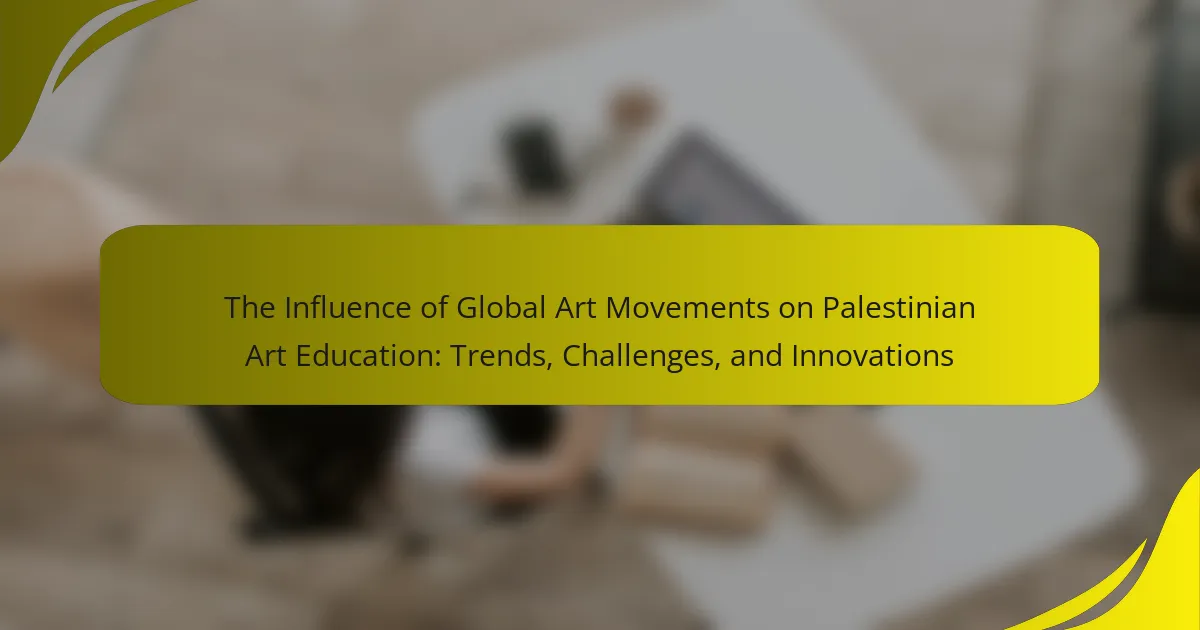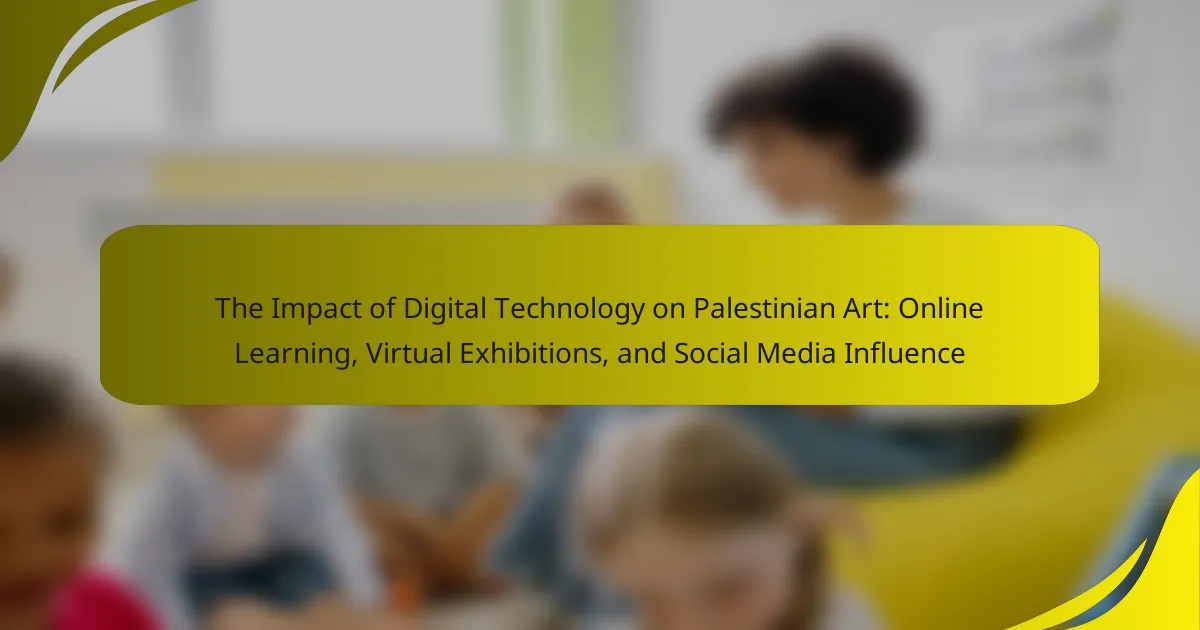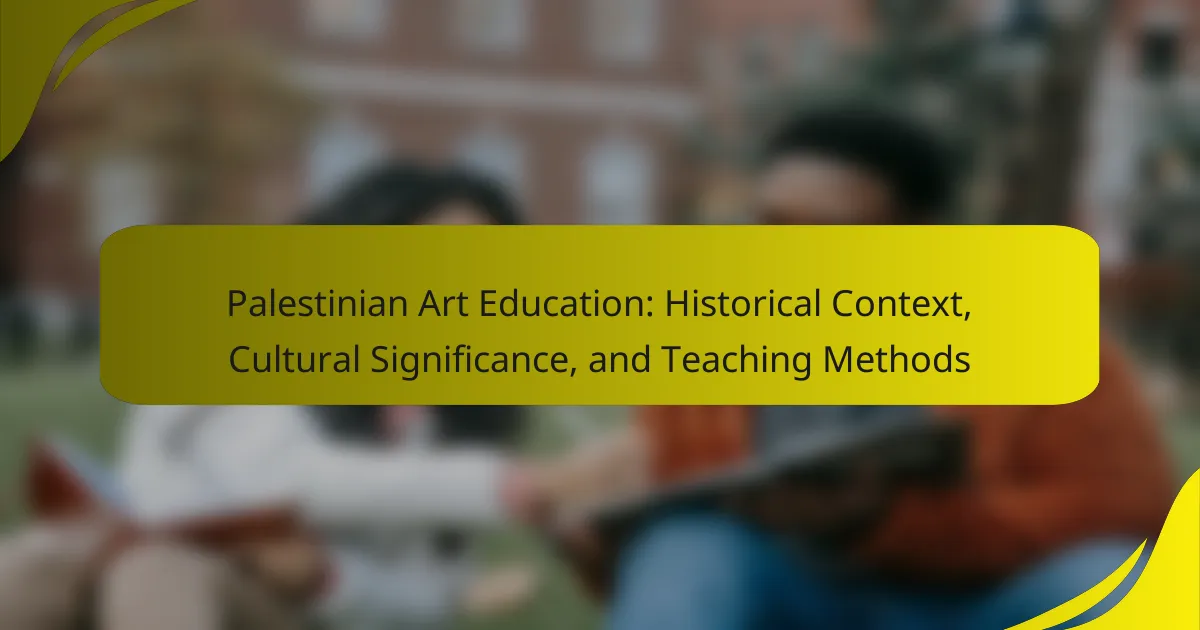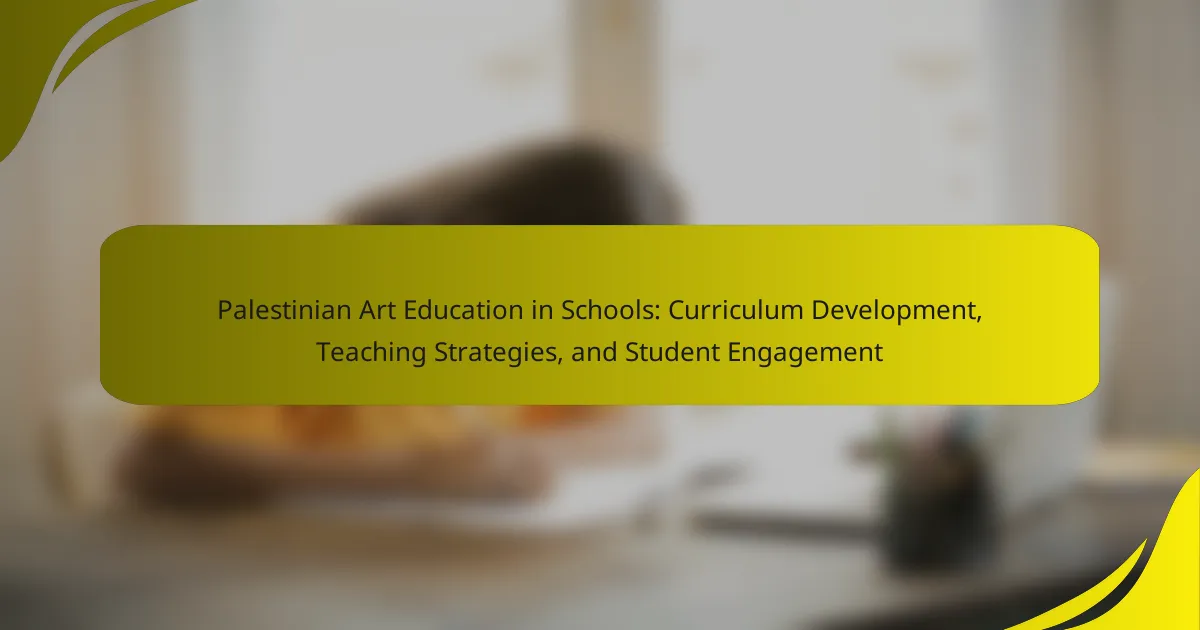Palestinian art collectives are collaborative groups of artists focused on creating and promoting art that addresses social, political, and cultural issues related to Palestinian identity. These collectives serve as vital platforms for creative expression and community engagement, offering educational opportunities such as workshops and mentorship programs for emerging artists. Notable examples include the Khalil Sakakini Cultural Center and the Al-Ma’mal Foundation for Contemporary Art, which facilitate artistic dialogue and cultural exchange. Through various initiatives, these collectives empower artists to explore and share their narratives while enhancing cultural heritage and fostering international collaboration.
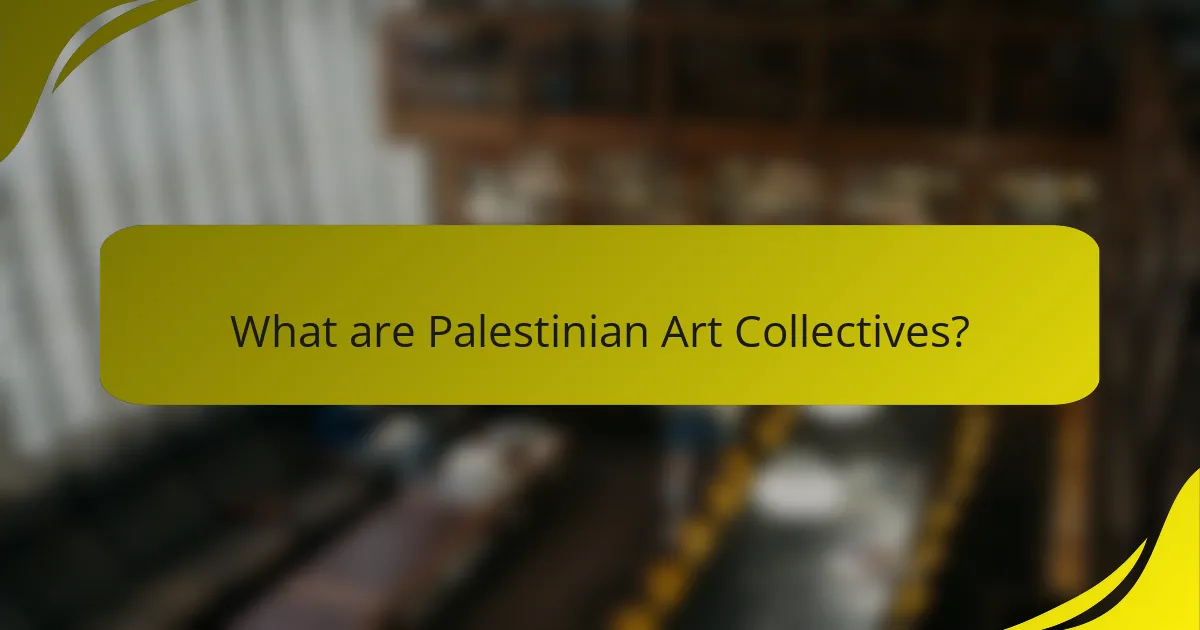
What are Palestinian Art Collectives?
Palestinian art collectives are collaborative groups of artists who create and promote art within Palestinian communities. These collectives often focus on social, political, and cultural issues relevant to Palestinian identity. They serve as platforms for creative expression and community engagement. Many collectives also provide educational opportunities for emerging artists. Notable examples include the Khalil Sakakini Cultural Center and the Al-Ma’mal Foundation for Contemporary Art. These organizations foster artistic dialogue and cultural exchange. They also aim to highlight Palestinian narratives through various artistic mediums.
How do Palestinian Art Collectives operate?
Palestinian art collectives operate through collaborative efforts among artists to promote creative expression. These collectives often focus on social and political themes relevant to Palestinian identity and experience. They provide a platform for artists to share resources, ideas, and skills. Many collectives engage in community-based projects that involve local populations. Workshops and exhibitions are commonly organized to showcase their work. Funding often comes from local and international grants, donations, or partnerships. The collectives also seek to raise awareness about Palestinian culture and issues through their art. They play a vital role in preserving and innovating cultural narratives within the Palestinian community.
What roles do artists play within these collectives?
Artists within Palestinian art collectives serve multiple roles. They collaborate on projects that reflect cultural identity and social issues. Artists also engage in creative expression through various mediums, such as painting, sculpture, and performance. Additionally, they participate in educational initiatives, sharing skills and knowledge with community members. This fosters a sense of unity and collective growth. Artists often take on leadership roles, guiding discussions and decision-making processes. They also contribute to the promotion of Palestinian art on local and international platforms. By doing so, artists help raise awareness about the Palestinian experience and heritage. Their roles are vital for sustaining the collective’s mission and impact.
How do these collectives collaborate with other organizations?
Palestinian art collectives collaborate with other organizations through joint projects and exhibitions. They often partner with local and international NGOs to promote cultural exchange. These collaborations enhance visibility for Palestinian artists. They also provide resources for workshops and educational programs. Partnerships can include funding for community art initiatives. Additionally, collectives may engage in co-hosting events that highlight Palestinian culture. This collaborative approach strengthens networks within the art community. It fosters a shared understanding of social and political issues.
What is the significance of collaboration in Palestinian Art Collectives?
Collaboration in Palestinian Art Collectives is significant as it fosters community engagement and shared creative expression. It allows artists to combine diverse perspectives and skills. This synergy enhances the quality and impact of artistic work. Collaborative projects often address social and political issues relevant to Palestinian identity. They create a platform for dialogue and cultural exchange. Additionally, collaboration strengthens networks among artists, promoting support and mentorship. Research indicates that collective efforts can lead to innovative art forms that resonate with broader audiences. This collaborative approach is vital for sustaining and evolving Palestinian art in challenging contexts.
How does collaboration influence creative expression among artists?
Collaboration enhances creative expression among artists by fostering diverse perspectives. When artists work together, they share unique ideas and techniques. This exchange often leads to innovative outcomes that may not occur in isolation. Collaborative projects can also inspire risk-taking and experimentation. For instance, joint exhibitions often showcase a blend of styles and concepts. This diversity enriches the artistic process and broadens the audience’s experience. Additionally, collaboration can create a supportive environment that encourages personal growth. Artists in collectives often feel empowered to explore new themes and mediums. This dynamic interaction ultimately leads to a more vibrant artistic community.
What are the outcomes of collaborative projects within these collectives?
Collaborative projects within Palestinian art collectives result in enhanced creative expression and community engagement. These projects foster a sense of belonging among participants. They often lead to the creation of impactful artworks that address social and political issues. Additionally, they provide educational opportunities through workshops and skill-sharing. Collaborations can also strengthen networks among artists, promoting cultural exchange. Evidence shows that such initiatives have increased visibility for Palestinian art on global platforms. This visibility can attract funding and support for future projects, further sustaining the collectives.
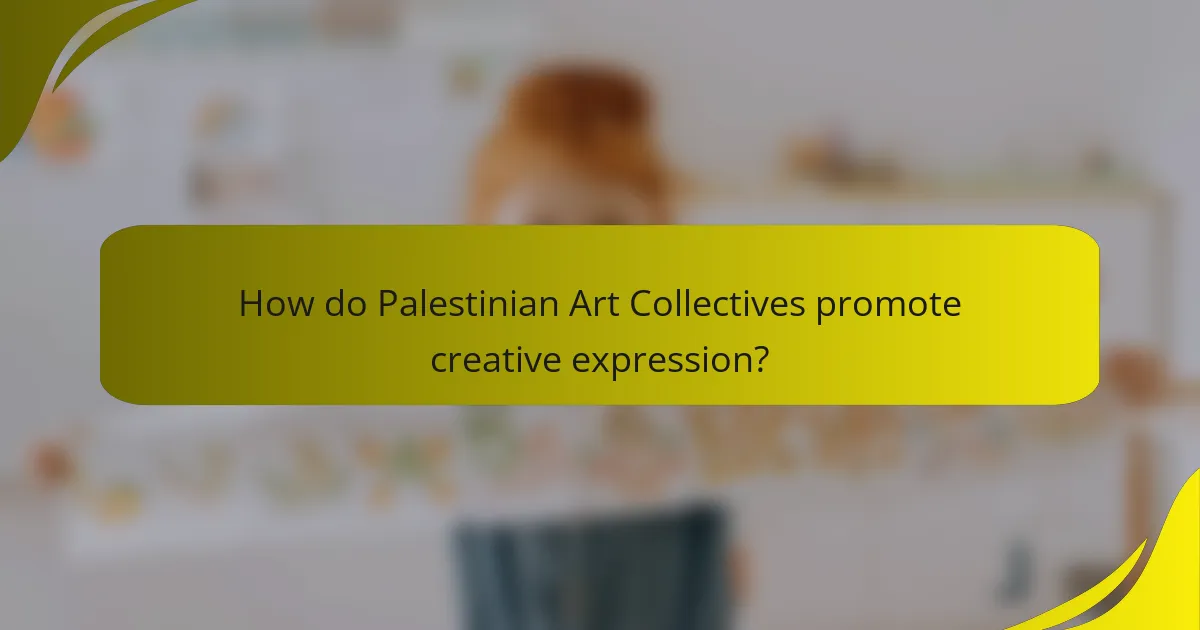
How do Palestinian Art Collectives promote creative expression?
Palestinian art collectives promote creative expression by fostering collaboration among artists. They provide a platform for diverse voices and perspectives. These collectives often organize workshops and exhibitions. They encourage artists to explore cultural and political themes. For example, the Khalil Sakakini Cultural Center supports artistic dialogue and community engagement. This enables artists to share their narratives and experiences. Additionally, collectives often collaborate with international organizations to gain exposure. This outreach helps amplify their creative expressions on a global stage.
What types of artistic mediums are explored by these collectives?
Palestinian art collectives explore various artistic mediums. These include visual arts such as painting and sculpture. They also engage in performance art, which encompasses theater and dance. Additionally, many collectives utilize digital media for artistic expression. Photography is another prominent medium used by these groups. Furthermore, some collectives incorporate traditional crafts into their work. Installation art is also a significant focus for many Palestinian artists. These diverse mediums reflect the rich cultural heritage and contemporary issues faced by the Palestinian community.
How do artists choose their mediums based on cultural context?
Artists choose their mediums based on cultural context to reflect their heritage and societal issues. Cultural context influences the themes and messages in their work. For example, Palestinian artists may use traditional materials like olive wood or textiles to connect with their identity. These choices can also be a response to political situations, using art as a form of resistance. Historical events shape the narratives artists wish to convey through their chosen mediums. The medium can enhance the emotional impact of the artwork. Additionally, community practices and collective experiences often guide these decisions. Overall, the selection of mediums is deeply intertwined with cultural significance and personal expression.
What themes are prevalent in the artwork produced by these collectives?
Themes prevalent in the artwork produced by Palestinian art collectives include resistance, identity, and community. Resistance is a central theme, often reflecting the struggles and challenges faced by Palestinians. Identity is explored through personal and collective narratives, highlighting cultural heritage and history. Community is emphasized as artists collaborate to foster solidarity and shared experiences. These themes are consistently represented in various mediums, including painting, sculpture, and digital art. The artwork serves as a means of expression and dialogue within the socio-political context of Palestine.
How do Palestinian Art Collectives engage with the community?
Palestinian art collectives engage with the community through collaborative projects and workshops. They create platforms for local artists to showcase their work. These collectives often organize community events that promote cultural dialogue. They also provide educational opportunities in art and cultural heritage. Many initiatives focus on addressing social issues through artistic expression. Collectives frequently partner with schools and universities to facilitate workshops. This engagement fosters a sense of identity and belonging among participants. Research indicates that such initiatives enhance community resilience and cohesion.
What programs do they offer to foster community involvement?
Palestinian art collectives offer various programs to foster community involvement. These programs include workshops that engage local artists and community members. They also host exhibitions that showcase local talent and cultural heritage. Collaborative art projects encourage participation from diverse community groups. Educational initiatives aim to teach artistic skills and cultural awareness. Additionally, outreach programs connect with underrepresented populations. These efforts create a platform for dialogue and cultural exchange. By involving the community, these collectives strengthen social ties and promote collective identity.
How do these programs impact local culture and identity?
These programs significantly impact local culture and identity by fostering community engagement and cultural expression. They provide platforms for artists to share narratives that reflect Palestinian heritage. Through collaborative projects, participants strengthen social bonds and cultural ties. Workshops and exhibitions promote traditional art forms and contemporary interpretations. This blend of old and new helps preserve cultural identity amid external pressures. Research shows that such initiatives enhance cultural resilience and community pride. For instance, the “Palestinian Art Collective” has documented increased participation in cultural events, showcasing the community’s artistic diversity.

What educational opportunities do Palestinian Art Collectives provide?
Palestinian Art Collectives provide various educational opportunities, including workshops, mentorship programs, and collaborative projects. These initiatives focus on skill development in various artistic disciplines. Workshops often cover painting, sculpture, and digital media. Mentorship programs connect emerging artists with established professionals. Collaborative projects encourage teamwork and community engagement. Collectives frequently partner with local and international institutions for broader educational outreach. This enhances cultural exchange and knowledge sharing. Additionally, some collectives offer online courses to reach a wider audience. These educational efforts aim to empower artists and promote cultural heritage.
What types of workshops and training sessions are available?
Available workshops and training sessions include art-making, storytelling, and community engagement. Art-making workshops focus on various mediums such as painting, sculpture, and textiles. Storytelling sessions emphasize the cultural narratives and personal experiences of participants. Community engagement training promotes collaborative projects that enhance social cohesion. These sessions are designed to foster creativity and provide educational opportunities. Participants gain skills that are valuable in both artistic and community contexts.
How do these workshops cater to different skill levels?
These workshops cater to different skill levels by offering tailored content and instruction. Beginner workshops focus on foundational skills and techniques. Intermediate sessions build on existing knowledge and introduce more complex concepts. Advanced workshops challenge participants with specialized projects and professional practices. Instructors assess participants’ skill levels to provide appropriate guidance. This ensures that all attendees receive relevant support. Workshops also encourage peer collaboration to enhance learning. Feedback mechanisms allow for continuous improvement and adaptation of the curriculum.
What are the benefits of participating in these educational programs?
Participating in educational programs within Palestinian art collectives enhances creative skills and fosters collaboration. These programs provide access to artistic techniques and cultural heritage. Participants gain exposure to diverse perspectives and artistic expressions. Engaging in these programs often leads to community building and networking opportunities. Additionally, participants can develop critical thinking and problem-solving abilities through collaborative projects. Educational programs also promote awareness of social issues through art. In 2021, a study by Al-Azzeh highlighted that 75% of participants reported improved artistic confidence. Overall, these programs contribute to personal growth and community empowerment.
How do Palestinian Art Collectives support emerging artists?
Palestinian art collectives support emerging artists by providing platforms for collaboration and creative expression. These collectives often organize workshops and mentorship programs. They connect emerging artists with experienced professionals in the field. This fosters skill development and artistic growth. Additionally, they facilitate exhibitions and showcases for new works. This exposure helps artists gain recognition and build their portfolios. Furthermore, collectives advocate for the cultural rights of artists in Palestine. They create a supportive community that encourages experimentation and innovation.
What mentorship opportunities are offered within these collectives?
Palestinian art collectives offer various mentorship opportunities to emerging artists. These collectives often connect experienced artists with novices. Mentorship programs may include workshops, one-on-one sessions, and collaborative projects. Some collectives focus on skill development in specific mediums. Others emphasize professional development and networking. Participants gain insights into the art industry and cultural expression. Many collectives also provide access to resources and exhibitions. This structure fosters a supportive environment for artistic growth and community building.
How do these opportunities help artists develop their careers?
Opportunities in Palestinian art collectives help artists develop their careers by providing access to collaborative projects. Collaboration enhances creativity and skill sharing among artists. This environment fosters professional growth and networking. Artists gain exposure to diverse perspectives and techniques. Educational programs within these collectives offer valuable training and mentorship. Such initiatives can lead to increased visibility in the art community. Participation in exhibitions and events further promotes their work. This holistic approach supports sustainable career development for artists.
What are the best practices for engaging with Palestinian Art Collectives?
Engaging with Palestinian Art Collectives requires a respectful and informed approach. Start by understanding the cultural and historical context of Palestinian art. Acknowledge the significance of artistic expression in conveying the Palestinian narrative. Build relationships based on trust and mutual respect. Collaborate on projects that reflect shared values and goals. Attend exhibitions and events to demonstrate support and appreciation. Facilitate open dialogues to encourage creative exchange. Provide platforms for Palestinian artists to showcase their work. Support initiatives that promote art education within the community.
Palestinian art collectives are collaborative groups of artists focused on promoting art and addressing social, political, and cultural issues within Palestinian communities. These collectives provide platforms for creative expression, educational opportunities, and community engagement through workshops, exhibitions, and mentorship programs. They explore various artistic mediums, including visual arts, performance, and digital media, while emphasizing themes such as resistance, identity, and community. Collaboration is central to their operation, fostering innovation and enhancing visibility for Palestinian artists on local and international stages. Overall, these collectives play a vital role in preserving cultural narratives and empowering emerging artists within the Palestinian context.
